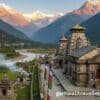Kauri Pass Trek is one of the best treks in the Garhwal Himalayas for adventure enthusiasts. The Kauri Pass is located at a height of 4,264 meters, offering a great view of some of the famous Himalayan peaks. If you want to witness the true beauty of nature while going on a thrilling adventure, then you must undertake this once-in-a-lifetime experience.
This pass is located in the Chamoli district of the Himalayas and it offers a beautiful view of lush green landscapes and massive snow-covered peaks. You’ll have the best time of your life while exploring the wonderful beauty of the Himalayas. Here’s a perfect tour guide to make your adventure journey a memorable one.
Best time for the trek
The Kauri Pass trek can be done throughout the year, but the best time for this trek is from May to June. This is the post-winter season that follows the snow melt, when accessibility of the trekking trail is available. The weather is favorable, and the whole area is covered with flowers, so this time of the year has a very beautiful landscape that is perfect for hiking.
Another best time for this trek is from September to November Once the rains end, however, it is clear skies in that region with a feeling of crisp and cool weather. In addition, spectacular peaks of surrounding mountains can be seen during this season, as the trekking routes are always in good condition after the monsoon season.
It is advised to avoid trekking during monsoon months, July to August, due to heavy rains that make trails slippery and tougher. Winter is also not suitable between December and April because the region generally receives much snowfall, and hence the trails might be covered with deep snow which makes it inappropriate for trekking.
Before going on a trek you must check the weather forecast for the latest weather information and do check all the permits according to local guidelines.
How to reach Kauri Pass
To reach Kauri Pass, you’ll have to start your journey from Rishikesh. To reach Rishikesh, there are three routes that you can take.
- you can take a bus from Rishikesh. It will be a comfortable overnight journey, you’ll easily find a direct bus from Rishikesh to the Kauri pass.
- If you are planning to travel by train,n then you’ll have to reach Haridwar first, which will be an overnight train journey to Haridwar and then after reaching there, you have to take a drive to reach Rishikesh. From Haridwar to Rishikesh it will take 35 minutes to cover the whole distance.
- You can also take a flight to Dehradun, it will be a way quicker journey than the bus or train. After reaching the Jolly Grant Airport of Dehradun you’ll have to take a drive to Rishikesh which is just 20-30 km away from the Dehradun airport.
After reaching Rishikesh your journey to Joshimath will start. You’ll have to take public transport from Rishikesh to cover the distance, it will take approximately 7-8 hours to complete this journey. After reaching Josimath you can book a stay in one of the guest houses and take some rest. Here’s a list of routes to reach Joshimath from Rishikesh.
1. Route one: This route will take you through the beautiful place, Auli. The picturesque view of this place will make you fall in love with it and it will also make your journey much more beautiful. You’ll have to trek through Galigarh to reach Kauri Pass. This trek will last for 5 days and there you’ll have to stay in the camps.
2. Route two: on your journey to Joshimath, you’ll pass through Tugasi, mirag, and Khulara. Then you’ll reach Galigarh and then you’ll have to trek to Kauri Pass. This route is best for people who want to skip traveling from Auli.
3. Route three: The third route will take you through the Tapovan Valley, from here your 16 km long trek to Josimath will start. You’ll pass through Malari and this path will lead you toward the Tapovan valley.
Kauri Pass trek difficulty level
The Kauri Pass trek is said to be a moderate to hard trek for those who have an experienced and reasonably fit body.
1. Altitude:
Kauri Pass is located at approximately 12,500 feet (3,810 meters) above the level of the sea. The altitude can prove to be a determining prospect of the level of difficulty in trekking, and people may even suffer from symptoms of altitude sickness. Acclimatization aims at reducing the risk that arises as a result of high altitude. To avoid AMS you should give your body some time to adapt to the environment.
2. Terrain:
The walk takes you through diverse landscapes that may include areas with steep climbs and descents, sharp rocky paths, and in some conditions, snow-covered sections. You should be ready for the hard climbing areas they may have to take, which could require swiftness and stamina.
3. Duration:
The Kauri Pass trek should last approximately between 6 to 8 days and travel a large distance. Walking for a long time can require endurance and thus, participants should have the ability to undergo extended hours out for the trail.
4. Weather Conditions:
The climate in the Himalayan region is unstable as it can change from intense heat to cold in an instant and also the weather conditions may change without warning. Trekkers should be ready to fight different conditions of weather conditions, from cold, rain, and even snow at various seasons of the year.
5. Remote Location:
Because Kauri Pass is situated in a faraway region and an area that needs to be developed, this adventurer decides to take part in this trek. This in turn implies unrestricted facilities and services, such that participants shall have a certain measure of self-reliance.
Itinerary for Kauri Pass Trek
It is estimated to require approximately 6 to 8 days to complete the Kauri Pass trek and the route followed may be slightly different upon the trekking agency or guide used.
Day 1: Haridwar/ Rishikesh to Josimath
- From Haridwar or Rishikesh, you can begin your travel to Joshimath.
- The drive would approximately take 10-12 hours and will go through beautiful territories.
Day 2: Joshimath to Lohajung
- Drive to Joshimath and accordingly to Lohajung as the base of the trek.
- It can roughly be said that the journey will take approximately 7-8 hours.
Day 3: Lohajung to Didina
- At 89 kilometers, start the journey from Lohajung towards Didina.
- The trail goes through the stunningly green forests and meadows.
Day 4: Didina to Auli Bugyal
- Walk from Didina to Auli Bugyal, the marvelous high-altitude grassland.
- Savor the vast view of the nearby peaks.
- After taking some rest there get back on the trails.
Day 5: Ali Bugyal to Patar Nachauni
- The walk continues from Ali Bugyal to Patar Nachauni.
- Get acquainted with a slow ascent to higher altitudes and a change in the surrounding landscapes.
- You can also get some amazing pictures clicked with great background
Day 6: Patar Nachauni to bhagwabhasha
- The trek begins at Bhagwabhasa along the steep climb to the Kauri Pass.
- The terrain gradually changes to a rockier nature as you ascend.
Day 7: Bhagwabhasa – Kauri Pass and then to Dharapatni
- Today, you’ll have to trek from Bhagwabhasha to Kauri Pass and after reaching, you’ll witness the immense beauty of nature.
- Take some rest and start your trek back to Dharapatni
- Stay overnight in Dharapatni
Day 8: Dharapatni to Joshimath as a Trek and Return
- Here comes the end of this thrilling journey
- Drive back to Joshimath or go ahead towards Haridwar/Rishikesh.
This is a long-duration journey and also one of the most challenging Himalayan treks. You’ll need to prepare yourself physically and mentally to complete this trek. Follow all the instructions given by your trek organizer and carry safety measures along with you.
Frequently asked questions
Q1. Which month is best to do the Kauri Pass?
One of the best times to conduct a Kauri Pass trek is during the late spring to early autumn months, that is, from May to June and then from September to November.
Q2. Is the Kauri Pass trek difficult?
The Kauri Pass trek is sometimes considered moderate and other times challenging. It involves high altitudes with varied terrains, and changing weather conditions.
Q3. Do you need to acclimatize for the trek to Kauri Pass?
Yes, acclimatization is essential since it is a high-altitude location. Adjusting to higher altitudes and spending at least a day or more acclimatizing reduces the risk of passing sickness.
Q4. At what height is Kauri Pass located?
Kauri Pass is located at an elevation of about 12,500 feet (3,801 meters) above sea level.
Q5. Should I trek with a guide, or I can trek alone?
Though seasoned trekkers can try the trek alone, if you have less trekking experience, it is better to hire a local guide to ensure safety and navigation and have a pleasant experience.



